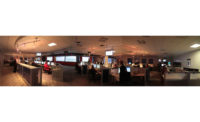The 2G communications sunset has already begun with reports of cellular carriers shutting down service of 2G towers (GSM and GPRS technology) in certain areas of the country. Many dealers have already been affected by these incidents — forcing them to upgrade customers as service is shut down. However, with AT&T’s announcement that it will cease all 2G communications by approximately Jan. 1, 2017, and other cellular carriers expected to follow, many dealers have a significant job ahead of them planning for massive upgrades without losing their customers or breaking the bank.
“If we ignore this, if we get bombarded with existing customers wanting an upgrade at the last minute, we physically won’t be able to meet our customers’ needs with staff or equipment and their systems may be down for a month before we get to them,” says Shooter Stein, president of National Certified Alarms (NCA), Nashville. As soon as 3G units became available from Stein’s manufacturer of choice, NCA stopped selling and installing 2G units and returned all 2G inventory to the vendor. Still, Stein estimates that NCA will need to update about 3,000 customers with 2G cellular communicators before the sunset.
Fortunately, other than a tower going out here or there, security dealers have several years to get their customers upgraded in anticipation of the sunset. With time on their side, many dealers plan to take on this project in phases so they are not overwhelmed by hundreds or, in many cases, thousands of upgrades at the same time.
“We generally do things like this in phases, because it is a lot more difficult to manage if you have to upgrade all your customers at once,” shares Jorgia McAfee, vice president of development, Crime Prevention Security Systems (CPSS), Gainesville, Fla.
CPSS, which is strictly on the 3G platform for any new installations, according to McAfee, is among a number of dealers that has already experienced problems with 2G units ceasing transmission in certain areas. “For those areas that we notice signal failures, we focus in and upgrade them to a 3G device right away,” she explains.
The Phases
Other dealers are focusing on tackling the 2G sunset in stages as well, and most acknowledge that phase one includes stopping any new 2G installations. American Alarm & Communications Inc., Arlington, Mass., stopped installing new 2G devices last summer, and has already begun replacing affected units on routine service calls and other installation work, according to Wells Sampson, president. The company’s “aggressive plan” is in the process of being finalized, he adds.
“It’s a slow process,” says Sampson, who estimates that around 15 percent of American Alarm & Communications’ customer base will need to be upgraded. “We will most likely do a combination of articles and information in our newsletter and email blasts. Then, of course, will be phone calls, which are what gets the lion’s share of the work done. You always have a minority of people jump on right away. A larger, middle group will go along with the upgrade if you persist, and then there is another, smaller subset of people that will resist for various reasons. It takes a lot of work and a lot of repetition to do an upgrade like this.”
By tackling upgrades with routine service and maintenance calls, many dealers hope to put a significant dent in the number of upgrades that will need to take place closer to the sunset date. “Over the next two years, every time we contact a customer whether through an accounting call or service call for example, the customer will be notified of the sunset and we will offer them a reduced price to upgrade their system,” explains Stein of NCA. In addition to phone calls, NCA plans to use mailers, email blasts and its current radio advertising to raise awareness on the issue and get ahead with the upgrade process.
Jeremy Bates, general manager of Sonitrol of Lexington Inc. & Bates Security, LLC, in Lexington, Ky., is in the formulation stages of a concrete plan for the company’s 800-plus 2G customers, but the company has had to tackle some upgrades already based on a few towers that went down in customer areas. “We’ve already had to deal with upgrades in certain locations, and we expect to begin experiencing more and more issues long before the actual sunset date hits, so we want to be very aggressive in our upgrade strategy,” Bates says. “We intend to have a multifaceted approach with all different areas of our personnel addressing this.” Bates adds that its sales force, inside customer service reps and service technicians will all be involved in educating those customers that will need to be upgraded.
Though ASG Security, Beltsville, Md., has already ceased new 2G installations, the company is waiting to see where manufacturers and communications technology will take them, before committing to a set-in-stone resolution. “ASG is still evaluating the best possible approach to the required equipment change out…Since the timing of the sunset is four years out, we do not believe it makes sense to begin the change out process just yet,” says Bill Rose, senior vice president, operations, who estimates that 30 to 35 percent of ASG Security’s customer base is currently using 2G.
Rose shares one of the main reasons ASG Security will continue to evaluate its plans for the upgrade is that, at this point, the only available options for upgrade are 3G communications (CDMA and HSPA+, also marketed as 4G) and, with the sunset still several years away, a newer technology such as LTE (also known as true 4G) could still be made available to the security industry. In addition, Rose adds, “there will be some level of customer attrition, and it does not make sense to upgrade the technology now (unless connectivity becomes an issue) until we get within 24 months of the announced sunset.”
The Cost
Once dealers determine how they will contact 2G customers to notify them of the impending upgrade, making the financial strain of the upgrade as small as possible will also be a part of the plan. Many dealers will focus on getting their costs covered or offering incentives to residential customers to lessen the cost to the company while focusing on reducing attrition.
“We will probably end up having to sell [the devices] at cost or just above cost to cover labor,” says Marcus Fontenot, director of Acadiana Security Plus Inc., of Broussard, La. “This is not something the customer is asking for so you can’t just knock on their door and say, ‘I have to change this and it will cost money.’ It’s going to be a combination of the customer picking it up with incentives and possibly turning some units into leases.” With the advanced mobile phone service (AMPS) technology sunset in 2008, Fontenot says that Acadiana began leasing upgraded units to some customers so that, in the future, the customer would not have to pay for the cost of a hardware upgrade.
“I have a strong feeling that a lot of customers will be upset, and we will end up making the same concession of leasing the units like we did before. Financially, it’s a very large deal, but you do what you can to keep the customer happy and keep the client,” Fontenot says.
Many dealers are hoping that educating the customer on the technology sunset will help customers understand that this technology upgrade is necessary — just like upgrading their cell phones or computers. “It’s important to let the customer know that in order to keep up with technology and all the added services available, a new system is necessary. It can generate more dollars for us and more technology for them to use,” shares Michael Miller, president of Moon Security Services Inc., Pasco, Wash. “At the end of the day though, we must tell them that phone providers are requiring us to do this and we have to pass the cost on to them as well — this is the force of nature.”
Miller, who estimates that about 25 percent of his customer base will be affected by the 2G sunset, says that the company is considering offering a “worry-free contract” to customers during the upgrade to help customers pass along the cost of another eventual technology upgrade on a month-to-month basis, rather than having to pay a large upgrade fee all at once. “This can help customers that don’t have the money upfront to pay for something like this, so working it out over a three- or six-month period can be helpful,” Miller adds.
One of the ways CPSS plans to help customers with the equipment, service and labor costs of the upgrade to 3G, according to McAfee, will be with its loyalty program that rewards customers with a $25 credit for each year they are a customer. The credits can be used toward additional services or upgrades. “With the program credits, most of our customers will already be able to pay for their device upgrade or make it very affordable,” McAfee shares. Many dealers say that they will focus on added features and abilities available with 3G/4G systems to help get customers on board with the necessary switch. “A lot of people aren’t really aware of the enhanced services available, so it’s a great opportunity to let them know you can implement things like controlling your thermostat and locks and all those other integrated features that we offer,” McAfee says.
David Balestrery, president of Sentry Security in Wheeling, Ill., agrees that the upgrade from 2G to 3G communications is a good opportunity to convert customers to the company’s interactive suite of services and gain additional RMR. “We expect to provide a financial incentive to upgrade the hardware and then make it attractive to the customer to expand to interactive services. We will have a balanced conversation with them about expecting a price increase but getting additional features like iPhone or iPad interactivity,” explains Balestrery, who estimated that roughly 25 to 30 percent of Sentry Security’s customers are on the 2G platform currently.
Despite whether dealers can gain additional RMR from the 2G sunset, the process will still be a financial burden on both end users and security companies. The most successful dealers will try to limit that burden by distributing the costs across the board as best they can, offering incentives to customers, and participating in manufacturer rebates and incentives for themselves.
“The impact is up to us. If we handle this in a way that is major drain on resources, it will be dreary for everyone involved,” Sampson cautions. “We have to make sure it’s a win for everyone and at least get our costs covered. It’s a shame that [a technology sunset] has to happen so often, but at this point we might as well accept that it’s going to be a process every few years.”
What’s Involved in a 2G Upgrade?
Most manufacturers have come out with 3G or 4G cellular communicators to replace their 2G counterparts and, for the most part, the actual upgrade itself will be fairly similar across the spectrum of products available. “There’s a slight variation from one manufacturer to another, but at the end of the day, a piece of hardware, not the entire panel, will need to be replaced,” explains Shawn Welsh, vice president of marketing and business development at Telguard, Chicago. He added that there are some cases where the actual panel will need to be replaced if the cellular communicator is built in, but those will be in the minority. “In the majority of cases, it’s the radio accessory that must be removed from the installed panel and replaced with a new accessory,” he says.
Typically, Welsh says most manufacturers’ cellular communicators are able to be installed with only one manufacturer’s control panels. Telguard’s cellular communicators are universally compatible, allowing dealers to choose equipment based on feature set, cost and ease of installation.
Honeywell’s radios also can be used with competitive panels, according to Gordon Hope, general manager of Honeywell Security & Communication’s AlarmNet business, Melville, N.Y. “Honeywell radios are optimized for use with Honeywell products, however, they can be used on competitive panels. Some dealers have asked us about standardization over the years because they want to be able to offer some of our products and services that they might not have had available before,” Hope confirms.
Existing wiring should be able to remain at the installation site and the installation process itself is a one-technician job that takes around 30 minutes, according to dealers. There are an estimated 3 to 5 million 2G communicators currently installed.
Will the FCC Postpone the 2G Sunset?
When the security industry considers the 2G Sunset, it is hard not to look for parallels in the past to help establish the appropriate response in the present. For this event, there isn’t a better example than the AMPS Sunset. Its rumblings started around 2000, but it didn’t happen for another eight years because of federal government intervention. Unfortunately, facts and myths have become blurred on the reason for the delay, leaving many in our industry to expect the same intervention with AT&T’s planned sunset of its GSM network on December 31, 2016.
For an unbiased opinion, one need go no further than to the security industry’s chosen standard-bearer with the FCC, the Alarm Industry Communications Committee (AICC), for answers. The question was simple. We asked, “Can the FCC delay AT&T’s planned sunset of 2G?” Equally simple was the answer. The AICC’s chairman, Lou Fiore, stated, “Going forward, sunsets are business decisions made by the carriers — not forced on them by the FCC.” He continued to share that despite our best efforts, the security industry actually failed to delay the AMPS Sunset. The winning appeal came from lobbyists for the hearing-impaired; a group now silent on AT&T’s announcement.
If history is to be our guide, then we must accept that the FCC will not ride to our rescue, because it never actually has. Plan for the sunset; start using 3G/4G equipment; do not wait for miracles. — Contributed by Shawn Welsh, vice president of Marketing and Business Development, Telular
MORE ONLINE
For more of SDM’s previous coverage on the topic, and to stay updated on new developments as they break, search 2G Sunset at www.sdmmag.com. Several articles have profiled the technology including:
The 2G Sunset has Begun: www.sdmmag.com/sunsetbegins
AT&T Sets 2G Sunset: www.sdmmag.com/att2g
Telguard Rewards Dealers With $25 Incentive for Replacing 2G Cellular Units: www.sdmmag.com/replace2g







